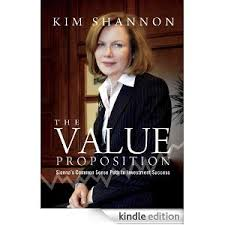“I believe financial statements are as much marketing documents as statements of fact,” said Kim Shannon, President, Founder and Chief Investment Officer of Sionna Investment Managers. She was addressing a crowd of analysts and financial managers at a breakfast meeting organized by the CFA Society Toronto on March 5, 2014, in the historic National Club.
The first part of Shannon’s presentation tied in directly with her new book, The Value Proposition. Shannon wrote 80 pages of the first draft, and then stopped while she established the company and guided it through the next decade (which included the 2008 financial crisis). Years later she returned to polish up the manuscript.
 Shannon described how the team of analysts at Sionna treat financial statement reading as an intellectual game or a who-dun-it, “looking for things that don’t line up.” A tried-and-true questionnaire of 18 sections with multiple questions provides a thorough, methodical approach to evaluating a company’s worth.
Shannon described how the team of analysts at Sionna treat financial statement reading as an intellectual game or a who-dun-it, “looking for things that don’t line up.” A tried-and-true questionnaire of 18 sections with multiple questions provides a thorough, methodical approach to evaluating a company’s worth.
“We ask: does the company have a sustainable comparative advantage?” she said. The analyst must look for “the theme in the story” that often runs throughout the answers to the 18 questions.
The financial statements are tested for signs of aggressive accounting. When it comes to dubious accounting practices, Shannon said she subscribes to the “cockroach theory,” namely, “there’s never just one.”
Shannon pointed out that the question, “where is the economy going?” has very little bearing on what individual stocks do. A graph of equity returns versus long-term GDP growth for many developed nations showed, on the whole, a weak correlation of the two (0.17).
It is the price paid that determines the return, according to Shannon. A chart of 10-year forward real returns based on S&P P/E ratios (from 1871 to 2010) showed an average growth of 15 percent when the stocks had P/E less than 6. The growth was zero, however, when the P/E ratio was 21 or greater.
“Most markets are not like the US—they are highly idiosyncratic,” said Shannon. That’s a good thing, because the law of comparative advantage applies. “We want markets to be different,” she emphasized. Her team makes full use of Canada’s special strengths in the resources sector, especially gold, and in banks.
Portfolio construction is “the workhorse of fund management,” said Shannon. Every other month, the team at Sionna has an all-day portfolio construction meeting because stock weighting can at times shift dramatically over the interim.
Value managers must contend with business cycles, especially looking for counter-cyclical companies when times are tough. “We try to be industry group-neutral in all sectors,” she said. That means taking a “relative value” approach, choosing the least expensive stock in a sector, out of several that may all be over-priced (compared to another sector).
Shannon closed the first half of the presentation with a 500-year-old piece of investment advice from Jacob Fugger the Rich:
 Divide your fortune into four equal parts: stocks, real estate, bonds and gold coins. Be prepared to lose on one of them most of the time. During inflation, you will lose on bonds and win on gold and real estate: during deflation, you lose on real estate and win on bonds, while your stocks will see you through both periods, though in a mixed fashion. Whenever performance differences cause a major imbalance, rebalance your fortunes back to the four equal parts.
Divide your fortune into four equal parts: stocks, real estate, bonds and gold coins. Be prepared to lose on one of them most of the time. During inflation, you will lose on bonds and win on gold and real estate: during deflation, you lose on real estate and win on bonds, while your stocks will see you through both periods, though in a mixed fashion. Whenever performance differences cause a major imbalance, rebalance your fortunes back to the four equal parts.
In an industry where great emphasis is placed on “the latest new thing” it was surprising and reassuring to be reminded the fundamentals of value investing are indeed timeless. ª
Click here for the second part, where Shannon describes how she attracted the top talent at Sionna. ª
Click here for the Kindle version of The Value Proposition at Amazon.
Interested in reading more about Jacob the Rich? Check out the book, The Richest Man Who Ever Lived: The Life and Times of Jacob Fugger, written by Greg Steinmetz. Click here for a review of the book

